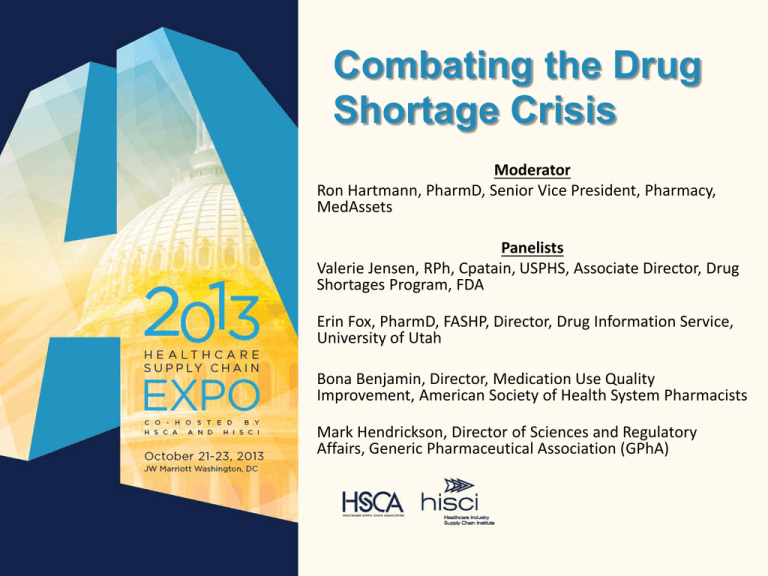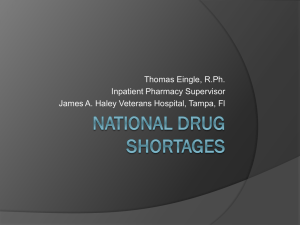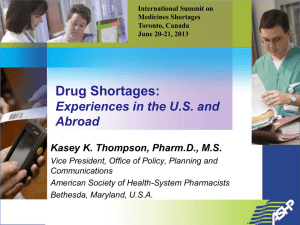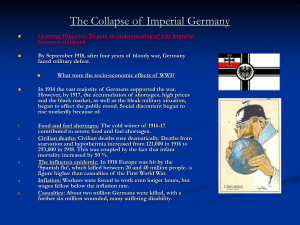Drug Shortages - Healthcare Supply Chain Association
advertisement

Combating the Drug Shortage Crisis Moderator Ron Hartmann, PharmD, Senior Vice President, Pharmacy, MedAssets Panelists Valerie Jensen, RPh, Cpatain, USPHS, Associate Director, Drug Shortages Program, FDA Erin Fox, PharmD, FASHP, Director, Drug Information Service, University of Utah Bona Benjamin, Director, Medication Use Quality Improvement, American Society of Health System Pharmacists Mark Hendrickson, Director of Sciences and Regulatory Affairs, Generic Pharmaceutical Association (GPhA) Combating the Drug Shortage Crisis Erin R. Fox, PharmD Director, Drug Information Service University of Utah Hospitals and Clinicshttps://hscintranet.med.uta h.edu/document_center/Documen ts/DIS-Newsletter-InfluenzaVaccines-2013-2014-Season.pdf Disclosure This presentation represents my own opinions, not those of the University of Utah. Current Trends National Drug Shortages New Shortages by Year January 2001 to September 30, 2013 300 267 250 211 200 149166 129 150 120 100 204 88 109 73 58 74 70 50 0 01 02 03 04 05 06 07 08 09 10 11 12 13 Note: Each column represents the # of new shortages identified during that year Shortage National Drug Shortages – Active Shortages by Quarter Active Shortages 350 300 239 250 200 150 152 167 246 256 282 273 260 299 295 299 294 211 176 188 Shortages 100 50 Q3-13 Q2-13 Q1-13 Q4-12 Q3-12 Q2-12 Q1-12 Q4-11 Q3-11 Q2-11 Q1-11 Q4-10 Q3-10 Q2-10 Q1-10 0 Note: Each column represents the # of active shortages at the end of each quarter. University of Utah Drug Information Service Active Shortages Top 5 Drug Classes Active Shortages 9/30/13 60 50 40 30 20 10 0 50 39 31 37 26 Active Shortages University of Utah Drug Information Service What do these numbers mean? • Decreasing rate of new shortages • Ongoing shortages are not resolving • Continued daily impact for patients, clinicians, health systems, health care Why is this happening? Med Watch Trends – Reports Related to Safety, Medication Quality, and Compounding Quality 90 80 70 1 10 7 21 60 19 32 50 40 30 22 Compounding Quality 69 54 16 54 20 36 21 10 0 2009 2010 2011 2012 2013* http://www.fda.gov/Safety/MedWatch/default.htm *2013 are data through August Safety Fragile Supply Chain Generic Injectables • Concentrated market • Few products with > 3 suppliers • Manufacturing capacity – At capacity, no resiliency – Multiple products made on single line • Complex manufacturing process – No simple fixes for quality problems – Problems typically affect multiple products – ISPE survey identifies “Quality systems of manufacturing” as key cause of shortages http://aspe.hhs.gov/sp/reports/2011/DrugShortages/ib.shtml http://www.ispe.org/drug-shortages-initiative Economic Drivers Quality No Incentive Clin Pharmacol Ther. 2013;93:170-176 Clin Pharmacol Ther. 2013; 93:145-147 Not Transparent Example – Fragile Supply Chain Electrolyte / Nutrition Shortage Key supplier Warning letter 2011 Closed in 2012 Trace elements* Zinc, Selenium* Sodium phosphate Potassium phosphate Calcium gluconate Calcium chloride Sodium bicarbonate Zinc shortage results in dermatitis at Children’s National http://www.cdc.gov/mmwr/preview/mmwrhtml/mm6207a5.htm Where does FDA fit? FDA’s Role • FDA CAN require: Notification – FDASIA (Supply disruptions, discontinuations) – Manufacturing changes – No penalties • FDA CANNOT require manufacturers to: – Make a drug – Make more – Distribute in a particular way • FDA CANNOT fix a manufacturing problem Patient care is top concern FDA works to prevent and mitigate shortages FDA’s Approach • Prioritize based on medical necessity • Review risks / benefits of medication • Minimize risk to patients while maintaining availability • Work with manufacturers to address problems • Toolkit • Regulatory discretion • Request increased production • Expedite reviews • Temporary importation FDA Efforts • Prevention doesn’t work for every shortage • Unforeseen breakdowns, API shortage • Longstanding quality problems • Fixes can take a long time Summary • Drug shortages impact patients daily and are not resolving. • New suppliers are needed to manufacture generic drugs with both high quality and high reliability. • Hospitals need unit of use products – may be an opportunity for suppliers to enter the generic injectables market. Questions? Contact: Erin Fox Erin.fox@hsc.utah.edu Drug Shortages Summit 2013 Seeking long-range solutions for drug shortages Presented to : Healthcare Supply Chain Expo 2013 By: Bona Benjamin, Director, Medication-Use Quality Improvement American Society of Health-System Pharmacists October 22, 2013 The “difficult problem” of shortages Jul 12, 2002 Provisional Observations on Drug Product Shortages. Am J Health-Syst Pharm—Vol 59 Nov 15, 2002 Nov 5, 2010 Apr 19, 2013 Drug Shortages 2.0: Long range solutions Summit Agenda • Update on FDASIA and FDA’s strategic plan • GPhA update on ARI • Analysis of economic factors • Group discussion of quality, economic, and contributory factors * Woodcock, J, Wosinska, M. Economic and Technological Drivers of Generic Sterile Injectable Drug Shortages. Clinical Pharmacology and Therapeutics. 93-2: 170-176 http://www.nature.com/clpt/journal/v93/n2/pdf/clpt2012220a.pdf Economic factors • Inverse relationship between tolerance for shortage risk and price of drug • Buyers in the dark • Price remains fixed – market fails to correct shortage Discussion themes • Ongoing shortages persistent • Traceability issues • Inequitable distribution • Hoarding/stockpiling • “Leaking” supply chain • Paper pedigree • Low bid trumps guarantee of availability Areas to explore Legislative/Regulatory 1. Accelerate/streamline DEA quota procedures 2. Continue to enhance FDA communication to providers 3. Traceability Areas to explore Legislative/Regulatory 4. Consider the BARDA model 5. Give FDA sufficient resources to manage shortages 6. Require data that extends expiration dating, if needed. Areas to explore Economic incentives 7. Get payers involved 8. Offer multiple contract awards 9. Use FDA quality metrics in buying decisions 10.Explore corporate tax credits for firms that invest in quality Areas to explore - Other 11.Better methods for demand forecasting 12.Unit of use presentations 13.Essential Drug List Some good news • Increased collaboration between industry and FDA DSP • “Workable pathway” • Increased interest from new firms • End users: “Guaranteed availability worth the price.” Questions http://www.ashp.org/menu/DrugShortages.aspx Drug Shortages: Industry Prospective Mark Hendrickson Director for Sciences and Regulatory Affairs Generic Pharmaceutical Association Introduction • The drug shortage problem has hit crisis proportions and is of extreme concern for patients, clinicians, the pharmaceutical industry and policymakers. • Drug shortages represent a complex, multifaceted issue. • The generic pharmaceutical industry is devoted to working with all stakeholders to minimize current shortages and mitigate factors that could contribute to future shortages. Why Are Shortages Occurring? Causal factors of drug shortages are numerous and do not apply in every case. They include everything from: • An insufficient supply of available raw materials to meet demand. • Inadequate and delayed communications about shortages. • Unpredictable changes in product demand • Problems associated with the manufacturing and release of products. • Quality compliance • Limited number of production lines • Complexity of manufacturing sterile injectables • Most drugs are supplied by only one or two companies.* • Seven manufactures supply most of the market • Suppliers cite production-related issues and increased demand as top reasons for shortages.* • Hoarding of drugs in short supply can exacerbate shortage *Source: “Drug Shortages: A Closer Look At Products, Suppliers And Volume Volatility” IMS Institute For Healthcare Informatics, Nov. 2011 Drug Shortage by The Numbers The drug shortage problem is highly concentrated. • 58% of the drugs on the shortage list are produced by at least one facility undergoing remediation as a result of FDA action.* • Generic Injectables* • Make up over 80% of drugs in shortage. • Of the total generic injectable market, half are on the shortage list. • Oncology drugs make up the highest share of the shortages list at 16 %. *Source: “Drug Shortages: A Closer Look At Products, Suppliers And Volume Volatility” IMS Institute For Healthcare Informatics, Nov. 2011 Primary Difficulties Reported by Patients and Providers • No advanced warning and suggested alternatives • No information about cause of shortage • No information about duration of shortage • Difficulty obtaining suitable alternatives • Substantial resources necessary to educate practitioners on the use of alternatives • Possible loss of prior safety safeguards put in place Inspections & Drug Shortages: Is There a Correlation? Inspections & Drug Shortages: Is There a Correlation? In recent years, four trends have increased: • • • • Registered manufacturing sites Foreign inspections Warning letters Drugs in shortage Between 2000 and 2007, the number of warning letters issued to the generic injectable companies, who represent a significant portion of the generic injectable products currently listed on the FDA Drug Shortage website, was one (1)* Between 2008 and YTD 2013, the number of warning letters issued to these same generic injectable companies, was seven (7), a 7-fold increase* As a result of FDA actions, generic injectable companies have made the decision to take approximately 30% of the total capacity off-line for remediation efforts. *Source: FDA Website – FDA.gov/ICECI Accelerating the Recovery Accelerated Recovery Initiative • An unprecedented multi-stakeholder initiative designed to provide FDA with additional scope of vision into manufacturing production planning schedules. • Represents private-public sector partnership. • Predicted on voluntary, confidential communication between manufacturers, an independent third party (IMS Health), and the FDA. • Information made available through ARI is designed to increase visibility and improve decisions related to manufacturing capabilities and production of priority products. Accelerated Recovery Initiative The Premise: • ARI is designed to expand FDA’s “scope of vision” ARI uses real-time supply, distribution, and demand forecast information to determine current supply gaps compared to historical market requirements. This data could give the FDA a better understanding of current conditions internal to manufacturing company production planning and provide for realtime decisions. It could also provide the potential to expand the supply of critical medications, or avert future shortages. Accelerated Recovery Initiative The Process • GPhA will identify a subset of products on the Drug Shortage List based on inclusion criteria, and provide this list of drugs to IMS • GPhA will contact all of the manufacturers of the products on the list in an effort to sign them up to participate in ARI • Participating manufacturers are expected to: • Provide IMS with their respective 90 day supply schedules/forecasts covering those products • Update monthly the supply schedules • Provide IMS with immediate notice of unanticipated changes to the existing supply schedule • • IMS will prepare a “gap analysis” and send to the FDA FDA could then utilize all available information to assist it’s remediation efforts Accelerated Recovery Initiative The goal of the ARI is to: • Put in place industry practices that provide a more accurate, timely and comprehensive view of the current drug shortage situation. • Provide greater visibility to potential shortages solutions. • Establish processes that allow for potential, voluntary production adjustments to lessen or eliminate the impact of a current shortage. Thank you!












